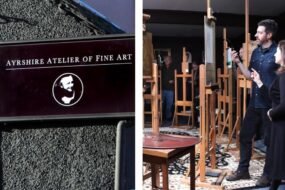
How do you imagine the quintessential Silicon Valley home to be decorated? An interior interpretation of the tech bro uniform: jeans-hoodie-gilet as kitchen-living-room-bedroom? Minimal, nondescript, in a palette of grey-on-black-on-white? Maybe with a touch of Bond lair to it. Gadgetry. Perhaps a Jeff Koons here, a Kaws figure there.
What you might not expect are living rooms layered with antique furniture and richly floral fabrics, a Shaker-style kitchen offset with a graphically grid-patterned floor, or an office clad in deep-green drapery — all featuring paintings and prints by a roll call of interesting mid-career artists. And yet this is what you’ll find in the interiors of San Francisco-based Lauren Geremia, who, having made her name in the early 2010s as an “upstart designer for tech”, creating office schemes for the likes of Instagram and Dropbox, has since mined a seam in decorating the homes of California’s engineers and innovators.
“Right now I’m doing a new-build in the South Bay for a tech client and he wants it to feel modern and reference Japanese heritage,” says Geremia. “The palette is pretty and ethereal, with hand-painted tiles among the textural accents,” adds the 43-year-old, auburn-haired designer, who — when we speak over Zoom — is seeking refuge from family life in her pink-walled bedroom, recovering from pneumonia, but brimming with energy.

From her HQ in San Francisco’s Mission District — a “dreamy workspace” in an art deco building — the Geremia team of 12 is currently overseeing a number of Californian projects that, style-wise, are “all over the place”, she laughs. They include “a super-tiny Eichler mid-century house in a neighbourhood of 200 other Eichlers”, and “a penthouse that has 360 views of the city, which was built in 1932 and has original stained-glass motifs and details”, she says. A pied-à-terre in upstate New York is also in the works.
Her studio’s take on interiors doesn’t adhere to a single aesthetic, she says, but these are spaces that often have an Arts and Crafts or Shaker feel to them — formal yet homey, elegant but offbeat. A recent highlight is a 1920 Berkeley house by architect Julia Morgan, which Geremia has rethought for a family with three young daughters. The colours — from the aubergine wall panelling of the living room to turquoise mouldings outlined in olive green in a bedroom — are inspired by 1930s watercolour paintings of the Berkeley City Club.
The aesthetic is a world away from the corporate spaces that first established her reputation — where meeting rooms were brashly labelled “romance chamber” or, next door, “the break-up room”, and a corridor jazzed up with a mosaic of pingpong balls. “It was really fascinating that I got known as a tech designer because I never worked in an office, I’m not a corporate person, I don’t know what engineers are like,” she says. “It really came out of nowhere.”

Where it actually came from, though, was from Geremia’s first tentative projects in San Francisco, a city she moved to as her partner at the time was studying painting at Stanford. “We had no money so I was getting jobs doing up bars and restaurants,” she says, describing projects such as drinking den Churchill as “scrappy” and “super fun”, featuring elements crafted by friends. “I think the people that went to those places happened to be the people that took over technology,” she suggests.
The move into offices required a swift stepping-up. “It was this crazy jump from me working by myself to having a company and hiring 15 employees to design this 90,000 square foot space,” she says. The experience brought about a number of realisations: first, “that I had an entrepreneurial edge”, and secondly that “I don’t like workplace design”.
She turned her attention to residential projects, which today make up 90 per cent of the studio’s work. “I pivoted to keep those [tech] clients but do their homes because it was not a bad lot of people to be connected to,” she smiles. “I did a lot of tech founders’ homes for the first couple years, and now my clientele includes actors and artists and all different types of people.” She remains discreet about naming any.


Geremia grew up on the east coast, outside New Haven, Connecticut, where she remembers visits to museums fuelling her interest in art and architecture. Her interest in interiors, meanwhile, she credits to her mum and her “over-the-top” approach to their classic colonial house: “She was a buyer for a department store, and a homemaker. I think she fancied herself as a bit of a Martha Stewart.”
But it was a trip to California, where she met an older cousin who worked for Walt Disney, that cemented her creative path. “He was working on The Little Mermaid and I saw his job, how he got to create for a living and draw things all day, and the whole thing just really worked for me,” she says.
She studied painting at Rhode Island School of Design (RISD), where her classmates included Shara Hughes, Genesis Belanger and Sanya Kantarovsky — artists who have been making waves with shows at blue-chip galleries including Pace, Michael Werner and Pilar Corrias, and selling work for some stupendous figures (in 2022 one of Hughes’s kaleidoscopic landscapes sold for nearly $3mn). “I always liked to paint rooms, interiors, landscapes, people, I was always interested in people,” she says. “But at school I also started to morph into making fabrics, wallpapers, more domestic-type things.”

Geremia’s art background is fundamental to her interior design approach. The process begins with hand-drawn sketches — “it’s how I work out everything: scale and shapes and forms”; she also makes watercolour paintings of the schemes, which are delicate, expressive artworks unto themselves. Often, she uses hand-painted motifs on furniture and walls; her own home, an eye-catching art deco monument between Corona Heights and Castro, features a self-designed and realised mural in the sewing room. And while her own artistic practice comes across in a painterly approach to both colour and composition, her love of art also influences the pieces she chooses to hang in a room.
“A lot of interior designers would go into a space and be like ‘We’re putting these chairs here’, but I think that way with paintings,” she says. “Sometimes when I look at a fireplace, I just know what should be there. But to get that Hayley Barker,” she says referencing the LA-based painter of dreamy gardenscapes, “is going to take me a year, right?”
Adding an art-consulting string to her offering was a natural progression for Geremia, who began her own collection with work by friends at RISD — from one of David Benjamin Sherry’s boldly monochrome landscape photographs to a realistic painting of flowers and grasses by George McCracken. “Then my friends would partner with people that were also artists and it just started to expand,” she says. “I’ve collected what I can afford — I have more art than furniture; it’s an issue — and then what I can’t afford I’ve pushed my clients towards.”


A striking example is one of New York-based artist Danielle Mckinney’s intimate and hotly sought-after paintings, which became the focal point of a cleverly layered bedroom. The work, showing a woman smoking, is hung upon a wall curtained in lemon yellow fabric, above a bed upholstered in a mid-century-esque floral. It might not sound like it would work, but it does.
The same could be said of the living room of a Victorian family home where a custom-antiqued mirror is mounted above the fireplace — and a photorealist painting of a San Francisco street by Robert Bechtle mounted on top of the mirror. A large and sculptural rope-clad pendant lamp adds to the playful, pleasing tension.
For Maya Ravi, co-founder of clothing range Hellenius Botanicals, working with Geremia on her Orinda home “challenged [mine and my husband’s] aesthetic assumptions”, she says. “Lauren taught us that taste evolves when challenged.” For another client who works in the tech sector, and with whom Geremia has worked on multiple properties across the Bay Area, it’s the art that stands out in the spaces. “They bring me joy every time I walk by,” she says. “I never get sick of looking at them — and I never could have found them on my own.”

In turn, it’s the clients who “push me into new places, who fuel my imagination to come up with new ideas”, says Geremia. “I’m not going to be happy unless there’s novelty and growth.” This could be projects further afield; she has her sights set on New England — “I would love to work there more,” she says. “I’m very much drawn to those houses” — but also Europe, in particular Rome, where she wants to convince friends to co-invest in a “place for making art and cooking and doing all the things that we love to do together”.
It’s a city she tries to visit every year, a source of inspiration and also antique finds. How her designs would evolve there remains to be seen, but one thing’s for sure: there will be little room for minimal grey-on-black-on-white — even for those tech bros.
Find out about our latest stories first — follow @ft_houseandhome on Instagram











